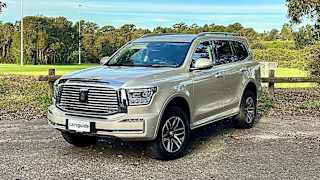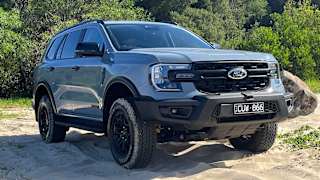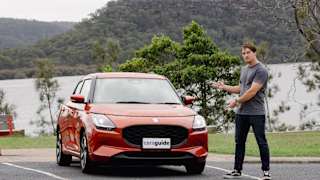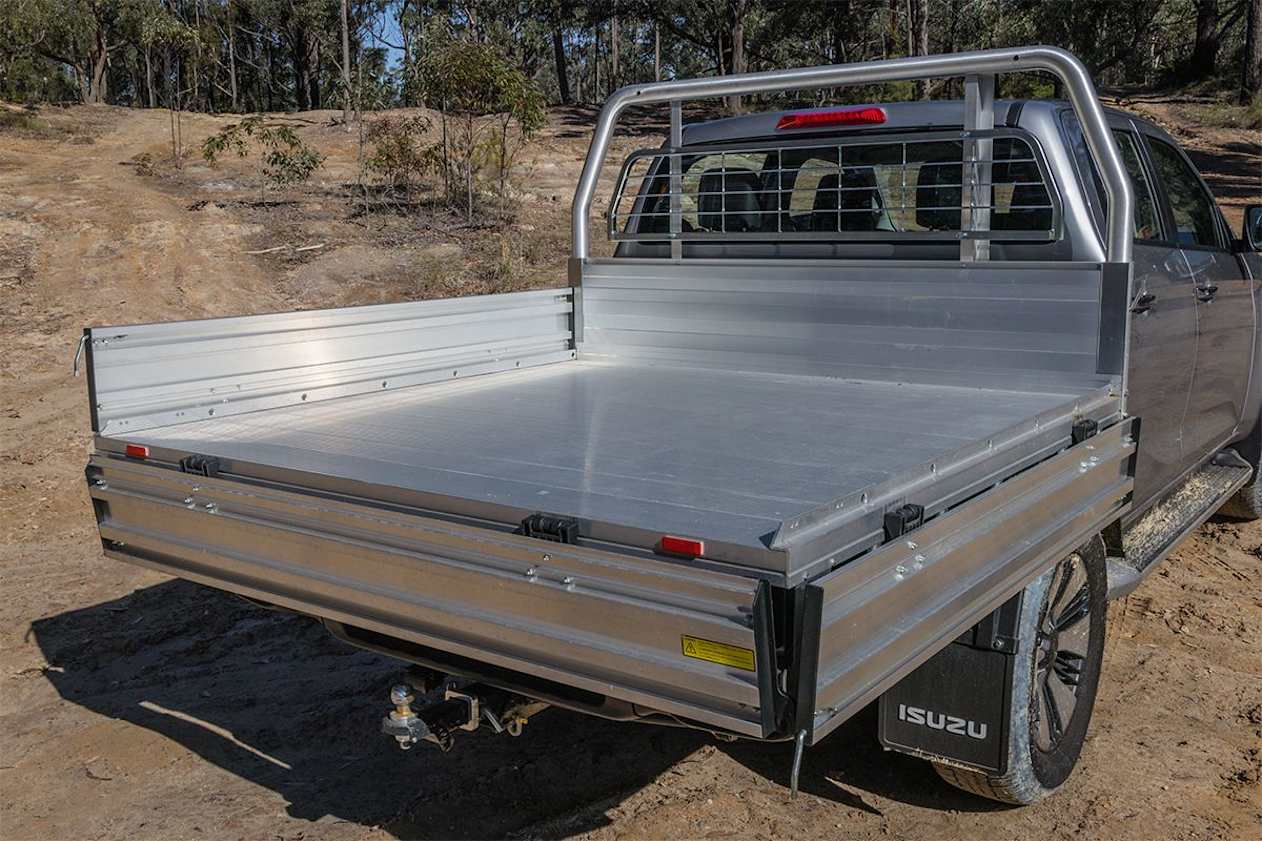Isuzu’s D-Max has grown a legion of fans in Australia over recent years and it’s rapidly become of the more popular utes in the Aussie market.
The D-Max Crew Cab Chassis ute, a new mid-spec variant in Isuzu’s ute line-up, is part of a recent range update and extension.
This is auto, 4WD, and in LS-U spec and at just under $70,000 as tested, does it tick all of your work-and-play boxes? Read on.
Isuzu D-MAX 2023: LS-U (4X4)
| Engine Type | Diesel Turbo 4, 3.0L |
|---|---|
| Fuel Type | Diesel |
| Fuel Efficiency | 8.0L/100km (combined) |
| Seating | 2 |
| Price From | $47,190 - $54,890 |
| Safety Rating |
|
Does it represent good value for the price? What features does it come with?
The Isuzu D-Max LS-U crew cab-chassis 4x4 auto has a manufacturer suggested retail price (MSRP) of $59,500, but with Mercury Silver metallic paint ($650), a Heavy Duty Alloy Tray ($2871) and on-road costs $5044, it climbs to $68,065. However, our test vehicle adds to the mix an electronic brake controller ($820), a tow bar wiring harness (12 pin flat, $359), tow tongue kit ($195.80), and stamp duty ($68.74) to push the price out to $69,508.54 driveaway.

Standard features include a 9.0-inch multimedia display with sat-nav, Android Auto and wired or wireless Apple CarPlay, an eight-speaker sound system, dual-zone air conditioning, keyless entry, push-button start, walk away door lock, auto-dimming rear view mirror, a factory-fitted tow bar receiver, and more.

The crew cab-chassis’ major point of difference with its ute tub body style stablemates is, of course, its tray, which you’ll get to choose: this is a heavy-duty alloy tray – and that costs about $2900 fitted – but there are economy alloy trays, general purpose alloy trays, and heavy duty steel trays available.
No matter the tray style, they’re all longer and wider – no wheel arches taking up load space – than the tubs, but they are shallower.

This D-Max has heavy-duty three-leaf suspension at the rear, engineered for load-carrying.
The standard range of paint finishes includes Basalt Black mica, Cobalt Blue mica, Mercury Silver metallic, Obsidian Grey mica, and Mineral White.
Premium exterior paint colours for this variant, include Magnetic Red mica, Marble White pearl, and Mercury Silver metallic (on our test vehicle).
Is there anything interesting about its design?
The crew cab-chassis certainly looks built for purpose, keeping in line with the work-based appearance of any self-respecting cab-chassis ute.
There are nice touches such as the chrome grille, handles and mirrors, as well as silver aluminium side steps and 18-inch two-tone machined alloy wheels.

The heavy-duty alloy tray looks the business and owners can always add an underfloor tool box or water tank, or even a ladder rack up top to make this ute even more work- and recreation-ready.
How practical is the space inside?
The LS-U’s cabin is basic, as it should be in a work ute, but well-designed.
High-grade cloth seats and carpet flooring with rubber mats are suited to work and rugged recreational shenanigans.

Upfront is comfortable and well equipped with an easy-to-use 9.0-inch multimedia touch screen (even I hooked up my smartphone, no worries), USB charge points, a plethora of storage spaces and everything is simple enough to access and use.
The seats are comfortable and, being high-grade cloth, are well-suited to long work days or, better yet, long trips away.
The back row is a comfortable space with a reasonable amount of head, leg, and knee room. There are also numerous storage spaces, including cup holders in the fold-down centre arm-rest, map pockets in the seat-backs, and bottle holders in the doors.
The rear of the centre console sports air vents and a USB charging point, and there’s a pop-out cargo hook in the back of the front passenger seat.
What are the key stats for the engine and transmission?
The D-Max has a 3.0-litre four-cylinder turbo-diesel engine (producing 140kW at 3600rpm and 450N at 1600-2600rpm), a six-speed automatic transmission, part-time four-wheel drive (2.482:1 transfer case; 33.3:1 crawl ratio), and a rear diff-lock.
The engine and auto make a proven combination, on and off road. The engine’s rarely stressed, the auto is generally a smart shifter – Isuzu is sticking with a six-speed transmission for now – and the D-Max has a comprehensive suite of driver-assist technology backing everything up.

This is not the torquiest 4WD ute on the market, but it more than makes up for that by delivering such an unstressed driving experience.
The D-Max’s part-time 4WD system has a dual-range transfer case (with high- and low-range 4WD), an off-road traction control system and a rear diff-lock. The driver is able to shift from 2H (two-wheel drive, high range) to 4H (4WD high range) while on the move, and up to speeds of 100km/h, The diff-lock may only be engaged when the vehicle is in 4L (4WD low range).
What's it like as a daily driver?
The LS-U crew cab-chassis has a listed kerb weight of 1960kg and a turning circle of 12.5m. It measures 5285mm long (with a 3125mm wheelbase), 1870mm wide and 1805mm high, so it occupies not an insignificant amount of space and yet it always feels very manoeuvrable.
Just prior to this vehicle test, I’d spent a two-week stint in an LS-U+ D-Max with the tub body-style – and driven more than 3500km in it – so I knew what to expect.
No surprises, good or bad here.

Tilt and telescopic adjustment mean you can get your steering wheel position just right and, once you’re on the move, steering itself is nicely weighted, with a comfortable feel in hand.
Throttle response is sharp enough, with crisp acceleration from a standing start and plenty of punch available when you need to smoothly and safely overtake another vehicle on the open road.
The D-Max’s engine and transmission, always a standout in this ute line-up, continue to give this ute plenty of appeal as a daily driver and touring vehicle. The only minor whinge is that engine noise can grow raucous under heavy throttle, but that’s easy enough to ignore when the D-Max is otherwise such a relaxed general-duties vehicle.
Otherwise NVH (noise, vibration and harshness) levels are properly subdued, with only some wind-rush around the big wing mirrors revealing itself every now and again.
Ride and handling are well-controlled. The suspension – wishbones and coil springs at the front, with three-leaf springs at the rear (heavy-duty examples here) – works well to take the sting out of most road-surface irregularities.
Of course, an unladen ute does tend to skip around at the rear a lot more than a laden ute, but Isuzu has done well to keep things mostly civilised here.
Niggles? All doors in a stationery D-Max lock automatically once all are closed, even momentarily. And they do so with a loud beep every time. Yep, first-world problems, but the wrong side of annoying when you’re packing/unpacking and someone closes a door and the opening process has to start all over again. You’d hope there’s a way to disable this function – including the beeps – or, at least, delay the auto-locking action, but I didn’t check the owner’s manual for a fix.
The adaptive cruise control is mostly cluey – maintaining your selected speed as required – but at times it can get a bit out of sorts, especially on long gradual hills, going uncomfortably faster or slower than your actual set speed.
All in all, the D-Max is still more than a little bit truck-like, but I don’t mind the fact that it’s not quite as refined as some rivals claim they are.
What's it like for touring?
The D-Max has a claimed 240mm of ground clearance, a wading depth of 800mm and approach, departure and ramp-over angles of 30.5 degrees, 20.6 degrees, and 24.3 degrees, respectively.
I’ve tested a lot of 4x4 D-Max variants over the years – including that recent long-distance test of the LS-U+ with the tub body style that I mentioned earlier – and these utes have all impressed in tough 4WD conditions. This one was no different.
I drove this ute on lightly corrugated dirt tracks and through coastal bush sand and deep mud holes.
The D-Max’s suspension does a good job of keeping everything settled when the blacktop becomes a gravel or dirt track.

The low-revving engine is not the torquiest one around, but it never seems stressed, in high- or low-range over a variety of terrain, and things just tick along nicely. There is ample accessible torque across a wide rev range, and that’s crucial when you're 4WDing.
Low-range gearing is sound (with a crawl ratio of 33.3:1), throttle response is good – with a pedal that’s not too sensitive to unintentional inputs when you’re bouncing around off-road – and the recalibrated traction control, while not quite as dialled-in as some of its rivals’ systems, is effective.
The D-Max’s electronic rear diff lock can be engaged at speeds up to 8km/h and only when you're in four-wheel drive low-range (4L). It will disengage when you hit 30km/h or more. Note: when you engage the diff lock, off-road traction control is disengaged. The rear diff lock is a very handy addition and one that’ll help to keep you moving along off-road on traction-compromised terrain and give you more peace of mind on the tracks.
Showroom-standard tyres are something of a vehicle-maker’s unnecessary evil because they are aimed at being quiet and comfortable on-road, while not atrocious off-road.

The D-Max’s road-biased rubber yields a quiet, comfortable ride on-road, sure, but they’re not suited to 4WDing. This is fortunately an easy issue to address: buy a set of decent all-terrain tyres to replace the existing rubber.
Ground clearance is listed as 240mm but the D-Max’s side steps and even its underbody feel vulnerable to grounding on dirt or on more substantial irregularities in the terrain (rocks, tree roots etc). Thankfully, the D-Max has factory-fitted 1.5mm-thick steel and 5mm-thick poly-composite underbody protection over powertrain components.

Slower, more considered driving will go some of the way to negating this low-riding sensation, but it can also be resolved with an aftermarket suspension lift if you plan to use your D-Max as an off-road tourer for destinations well beyond the beaten tracks.
The heavy-duty alloy tray is 1800mm long at floor height and about 1777mm wide because there are no wheel-arches taking up any load space. It has internal load-restraint points along either side of the base (supposedly 18 of them, but I didn’t count), quick-lock dropsides and tailgate, tail light protectors, wiring guard, rear-window protector, and alloy headboard tube. You can even add a ladder rack, under-tray tool box or under-tray water tank if you get the urge.
It has a listed payload of 1140kg, gross vehicle mass of 3100kg, an unbraked towing capacity of 750kg and a braked towing capacity of 3500kg.
With the latest round of updates, the GCM (gross combined mass) has been increased in all 4x4 D-Maxs by 50kg from 5950kg to 6000kg.
How much fuel does it consume?
Official fuel consumption is 8.0L/100km on a combined cycle.
On this test I recorded actual fuel consumption of 9.5L/100km. This figure is high, especially considering that I'd recorded 7.9L/100km over the more-than-3500km trip I completed in the LS-U+ tub body style, but it’s worth bearing in mind that this test involved a lot of low-range 4WDing.
The D-Max has a 76-litre fuel tank so, with that sort of fuel-consumption figure, you can reasonably expect a driving range of approximately 739km from a full tank, but that’s factoring in a safe-distance buffer of 50km.
Warranty & Safety Rating
What safety equipment is fitted? What safety rating?
The D-Max range has the maximum five-star ANCAP rating from testing in 2020.
The LS-U crew cab-chassis has eight airbags, and its comprehensive suite of active and passive driver-assist tech includes AEB, adaptive cruise control, lane keep assist, forward collision warning, blind spot monitoring, traffic sign recognition, auto headlights and high beams, reversing camera with rear cross traffic alert, front and rear parking sensors and more.
What does it cost to own? What warranty is offered?
The D-Max has a six-year/150,000km warranty and up to seven years of roadside assistance.
That warranty is okay in terms of years, but unlimited kms would make it more appealing.
Service intervals are scheduled for every 12 months or 15,000km, whichever occurs soonest.

Capped Price Servicing covers the first seven scheduled services (i.e. the first seven years of the new vehicle’s ‘life’). The cost per service is $409 at 15,000km, $429 at 30,000km, $629 at 45,000km, $529 at 60,000km, $319 at 75,000km, $769 at 90,000km, and $429 at 105,000km – for a total cost of $3513, according to Isuzu.
Servicing costs are getting steep and, in an increasingly competitive dual-cab ute market, potential buyers should scrutinise those.
Verdict
This D-Max crew cab-chassis is a handy all-rounder with plenty to like about its performance and refinement on and off road.
It’s comfortable and capable and while it’s not perfect as a daily driver or off-road tourer – no ute is – it definitely has a stack of positives going for it: an unstressed engine, and overall no-nonsense practicality and driveability.
And it’s those factors – and its comprehensive standard features list and suite of safety tech – that help to make the D-Max crew cab-chassis quite an appealing prospect as a work ute and as a touring ute.
Pricing Guides






























.jpg)
.jpg)

.jpg)
.jpg)
.jpg)


.jpg)